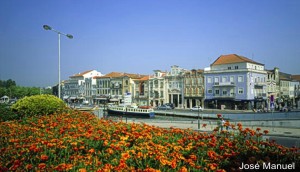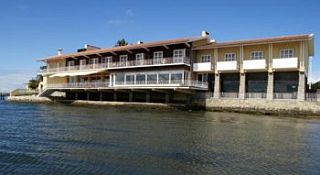
Murtosa-Torreira, PortugalLocated in northern Portugal, just south of Porto, it started out as an ancient settlement near the Ria and the early settlers used nets and canoes to catch the abundance of fish in the lagoon. This part of the coast eventually became one of the busiest in the world with ships sailing from northern Europe to the Far East and North America, aided by the Nortada that is one of the great sailing winds on the planet. The Pousada da Ria (Hotel Pousada Da Murtosa) is nestled in an area of natural beauty and looks out over a beautiful blue lagoon that connects Murtosa to the beaches of Sao Jacinto. The isthmus (or sandy strip of land), which separates the Ria de Aveiro from the Atlantic ocean, has since become a very popular spot during the summer months. Just north of the Pousada da Ria is the town of Torreira, which is a particularly popular resort, and only accessible by road from the north end. A unique feature of Torreira is the odd little dwellings called Plaheiros built from the hulls of old boats. 
At the end of the isthmus is the village of Sao Jacinto, Set in the heart of scenic forest with sand dunes stretching down to the sea, it is a marvellous place to watch migratory birds sheltering and nesting in the lagoon. The area of forest was planted over a century ago to protect the inland areas from the wind and sand. The San Jacinto Nature Reserve covers 700 hectares with trails and observation posts where you can watch the local wildlife in their natural habitat. From Sao Jacinto you can take a small ferry to Aveiro. Known as the Venice of Portugal, Aveiro is crossed with canals and has a main canal running through the centre of it. Moored on its banks are the Moliceiros boats, which are colourful boats very similar to the gondola style and used to trawl for seaweed and eels. Once a great seaport with links that went back as far as 959AD, the fishing trade was virtually ruined at the end of the 16th century when strong storms silted up the harbour mouth. The old quarter of Aveiro is quite charming with quaint whitewashed houses, and the most interesting are closer to the beach with very distinctive colourful facades. Early in the morning is the local fish market, the Mercado do Peixe, selling fish caught in the night. One of the specialities of this area is eel stew which is apparently quite delicious. Aveiro is also known for its sweets, and in particular the Ovas Moles, a small almond pastry with a sweet filling. Aveiro also has several beautiful churches worth seeing such as the 16th century Misericordia and the 15th century Cathedral Sao Domingos. There is also a museum in town that was established in 1911. Located in the old Covent of Jesus, this is where the tomb of King Afonso Vís daughter rests who died in 1490. If you are particularly interested in outdoor pursuits, there is hunting, fishing, horseback riding and mountain biking. For golf enthusiasts there is a choice of two excellent courses. So there is literally something for everyone who comes to visit this special part of Portugal. |